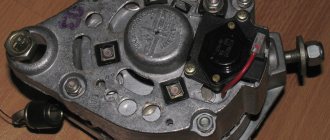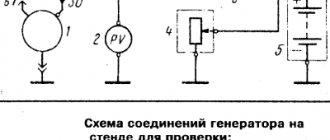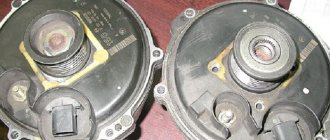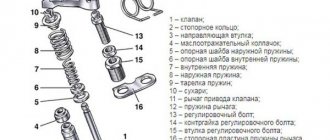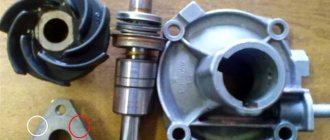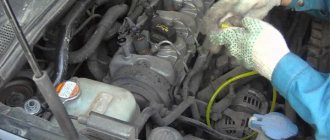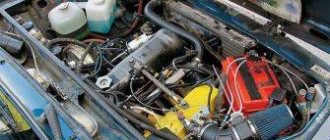A VAZ 2101 generator voltage relay-regulator is used to maintain the voltage level in the vehicle within the technically permissible value. A 2-stage vibration device RV-380 copes with the task. It is mounted in the area of the upper part of the mudguard above the left wheel. The intensity of the regulator's operation directly depends on the rotation speed of the generator rotor.
The faster it spins, the more voltage is generated. A technically well-functioning regulator quickly dampens any voltage surges that occur. The driver is informed about this by the stability of the sensor readings on the VAZ 2101 dashboard. If the readings become unstable, this indicates the need for a technical inspection.
Features of the VAZ 2101 generator
VAZ 2101 has two sources of electricity - a battery and a generator. The first is used when the engine is off, and the second while driving. The operating principle of the VAZ 2101 generator is based on the phenomenon of electromagnetic induction. It produces only alternating current, which is converted into direct current by a special device.
VAZ 2101 is considered one of the longest-living models, largely due to the performance of the generator
The main task of the generator is to uninterruptedly generate electric current to maintain the functionality of all electronic devices in the car, including recharging the battery.
Technical characteristics of the VAZ 2101 generator
The generator is connected to a crankshaft pulley that drives the water pump. Therefore, in the VAZ 2101 it is installed in the engine compartment to the right of the engine. The generator has the following technical characteristics:
- rated voltage - 12 V;
- maximum current - 52 A;
- the direction of rotation of the rotor is to the right (relative to the motor housing);
- weight (without adjustment unit) - 4.28 kg.
The manufacturer installed G-221 generators on the VAZ 2101
Selecting a generator for VAZ 2101
The manufacturer equipped the VAZ 2101 with generators of the G-221 model. The maximum current of 52 A was enough to operate all standard electrical appliances. However, the installation of additional equipment by car owners (powerful acoustics, navigator, additional headlights, etc.) led to the fact that the G-221 could no longer cope with increased loads. There was a need to replace the generator with a more powerful one.
Without any problems, you can install the following devices on the VAZ 2101:
- A generator from a VAZ 2105 with a maximum current of 55 A. The power is enough to operate a conventional speaker system and, for example, an additional LED strip for lighting. It is installed on standard mounts for the VAZ 2101 generator. The only differences are that the regulator relay is built into the generator housing, while on the G-221 it is located separately.
- Generator from VAZ 2106 with a maximum current of 55 A. Withstands slight overloads. Installed on standard G-221 mounts.
- Generator from VAZ 21074 with a maximum current of 73 A. Its power is sufficient to operate any additional electrical equipment. It is installed on standard VAZ 2101 mounts, but the connection diagram is slightly different.
- Generator from VAZ 2121 Niva with a maximum current of 80 A. The most powerful among its analogues. However, its installation on the VAZ 2101 will require significant modifications.
- Generators from foreign cars. The best option is generators from Fiat. Installing such a device on a VAZ 2101 will require noticeable changes in the design of the generator mounting and its connection diagram without guarantees of high-quality operation.
Photo gallery: generators for VAZ 2101
The generator from the VAZ 2105 is installed on the standard mounts of the VAZ 2101
The generator from the VAZ 2106 can withstand slight overloads and is installed on standard G-221 mounts
The generator power from the VAZ 21074 is sufficient to operate any additional electrical equipment
It is quite difficult to install a Niva generator on a VAZ 2101
In fact, it will be enough for the driver of a VAZ 2101 to install a generator from a “six” or “seven” to satisfy all his electricity needs. Even with complex tuning, a power of 60–70 amperes is enough to maintain the operation of all devices.
Connection diagram for the VAZ 2101 generator
The VAZ 2101 generator is connected using a single-wire circuit - one wire from the generator is connected to each device. This makes it easy to connect the generator yourself.
The VAZ 2101 generator is connected using a single-wire circuit
Features of connecting the VAZ 2101 generator
Several multi-colored wires are connected to the VAZ 2101 generator:
- the yellow wire comes from the warning light on the dashboard;
- a thick gray wire goes from the regulator relay to the brushes;
- a thin gray wire goes to the relay;
- The orange wire acts as an additional connector and is usually connected to a thin gray wire during installation.
Incorrect connection of wires can cause a short circuit or voltage surges in the electrical circuit of the VAZ 2101.
For ease of installation, the wires for connecting the VAZ 2101 generator are painted in different colors
Removing and installing the voltage regulator
Replacing the external voltage regulator VAZ 2101-2106
1) Using the “8” socket, unscrew the two nuts and remove the regulator.
2) Disconnect the two wires.
3) Attach the new regulator to the mudguard and connect the wires: orange to terminal “15”, and gray to terminal “67”.
Voltage regulator relay connection diagram
ATTENTION! Before starting the engine, make sure that the contact between the voltage regulator housing and the vehicle ground is reliable, and that the wires to terminals “15” and “67” are connected correctly.
The device of the VAZ 2101 generator
For its time, the design of the G-221 generator turned out to be quite successful. It was installed without modifications on subsequent models of the plant - VAZ 2102 and VAZ 2103. With proper maintenance and timely replacement of failed elements, it could be used for many years.
Structurally, the G-221 generator consists of the following main elements:
- rotor;
- stator;
- regulator relay;
- semiconductor bridge;
- brushes;
- pulley.
The G-221 generator is attached to the engine on a special bracket. This allows you to firmly fix the device and at the same time protect it from high temperatures.
The bracket firmly fixes the generator even when driving on uneven roads
Rotor
The rotor is the moving part of the generator. It consists of a shaft, onto the corrugated surface of which a steel sleeve and beak-shaped poles are pressed. This design serves as the core of an electromagnet rotating in two ball bearings. Bearings must be closed type. Otherwise, due to lack of lubrication, they will quickly fail.
The rotor (armature) is the moving part of the generator
Pulley
The pulley can be considered either part of the generator or a separate element. It is installed on the rotor shaft and can be easily removed if necessary. When the engine is running, the pulley rotates by the crankshaft through the belt and transmits torque to the rotor. To prevent the pulley from overheating, there are special blades on its surface that provide natural ventilation.
The generator pulley is driven by the crankshaft through a belt.
Stator with windings
The stator consists of a number of special plates made of electrical steel. To increase resistance to loads in four places on the outer surface, these plates are connected by welding. A winding of copper wire is laid on them in special grooves. In total, the stator contains three windings, each of which consists of two coils. Thus, six coils are used to generate electricity by the generator.
The stator consists of plates made of electrical steel, on which a winding of copper wire is laid
Regulator relay
The regulator relay is a small plate with an electrical circuit inside, designed to control the voltage at the output of the generator. On the VAZ 2101, the relay is located outside the generator and is mounted on the rear cover from the outside.
The regulator relay is designed to control the voltage at the generator output
Brushes
Generating electricity from a generator is impossible without brushes. They are located in the brush holder and attached to the stator.
Only two brushes are fixed in the brush holder of the G-221 generator
Diode bridge
The rectifier (or diode bridge) is a horseshoe-shaped plate with built-in six diodes that converts alternating current to direct current. It is important that all diodes are in good working order - otherwise the generator will not be able to provide power to all electrical appliances.
The diode bridge is a horseshoe-shaped plate
Another version of the VAZ-2101 scheme
Outdoor Lighting
1 – Headlights 2101 2 – engine compartment lamp; 3 – battery; 4 – generator; 5 – reverse light switch; 6 – fuse block; 7 – indicator lamp for external lighting in the instrument cluster; 8 – glove box lighting lamp; 9 – instrument cluster lighting lamp; 10 – plug socket for a portable lamp; 11 – instrument lighting switch; 12 – external lighting switch; 13 – brake light switch; 14 – ignition switch; 15 – lamp switches located in the front door pillars; 16 – lamp switches located in the rear door pillars; 17 – lampshades; 18 – trunk lighting lamp; 19 – rear lights; 20 – license plate light; 21 – reversing lamp
Turning on the headlights 2101
1 – headlights VAZ 2101; 2 – battery; 3 – generator; 4 – fuse block; 5 – headlight switch; 6 – external lighting switch; 7 – ignition switch; 8 – indicator lamp for high beam headlights in the instrument cluster
Direction indicators
1 – sidelights VAZ 2101; 2 – side direction indicators; 3 – battery; 4 – generator; 5 – ignition switch; 6 – fuse block; 7 – relay-interrupter of direction indicators; 8 – indicator lamp for direction indicators; 9 – direction indicator switch; 10 – rear lights
Sound signals 2101
1 – sound signals; 2 – battery; 3 – fuse block; 4 – sound signal switch; 5 – generator VAZ 2101.
Wiper circuit
1 – generator VAZ 2101; 2 – battery; 3 – ignition switch; 4 – windshield wiper switch; 5 – windshield wiper relay; 6 – windshield wiper gearmotor; 7 – thermobimetallic fuse; 8 – windshield wiper switch located in the glass washer pump; 9 – fuse block.
Heater fan Zhiguli
1 – generator VAZ 2101; 2 – battery; 3 – ignition switch; 4 – fuse block; 5 – heater switch; 6 – additional resistor; 7 – heater fan electric motor.
Ignition block diagram
The lock is attached to the steering shaft. Some of the power circuits, which are protected by fuses, are connected directly to the battery, regardless of the position of the key:
- interior lamp;
- sound signal;
- cigarette lighter;
- stop signal.
To adjust the voltage generated by the generator, a relay regulator is provided in the circuit. Its responsibilities include monitoring the voltage at the output of the generator, and when the readings drop, the relay sends a signal to the control lamp located on the instrument panel. If the charging voltage is low, the battery may discharge prematurely and not have time to recharge, which can damage it. If the charging voltage is too high, the electrolyte in the battery may boil, which will also not lead to anything good.
Diagnostics and troubleshooting of the VAZ 2101 generator
There are a number of signs and signals by which you can determine that the generator is faulty.
The charging indicator light comes on
On the dashboard of the VAZ 2101 there is a battery charging indicator. It lights up if the battery charge is close to zero. This usually happens when the generator is faulty, when electrical appliances are powered from the battery. Most often the light comes on for the following reasons:
- Slipping of the V-belt on the generator pulley. It is recommended to check the belt tension, and if there is severe wear, replace it with a new one.
- Failure of the battery charging indicator relay. You should check the serviceability of the relay using a multimeter.
- Break in the stator winding. It is necessary to disassemble the generator and clean all its elements.
- Severe brush wear. All brushes in the holder will need to be replaced, even if only one of them is worn out.
- Short circuit in the diode bridge circuit. The burned out diode or the entire bridge should be replaced.
The battery indicator lights up if the battery charge is close to zero.
Battery won't charge
One of the tasks of the generator is to recharge the battery while driving. If this does not happen, you should pay attention to the following points.
- Sagging V-belt. It is necessary to adjust its tension or replace it.
- Loosening of the wire ends connecting the generator to the battery. All contacts should be cleaned or damaged tips should be replaced.
- Battery failure. This can be checked and fixed by installing a new battery.
- Damage to the voltage regulator. It is recommended to clean all contacts of the regulator and check the integrity of the wires.
The problem with the battery not charging is most often associated with a malfunction of the battery itself.
The battery is boiling over
If the battery begins to boil away, then, as a rule, its service life is coming to an end. In order not to risk the new battery, it is recommended to accurately identify the cause of boiling. It could be:
- Lack of permanent contact between the generator voltage regulator housing and ground. It is recommended to clean the contacts and replace them if necessary.
- Short circuit in the regulator. The voltage regulator needs to be replaced.
- Battery failure. A new battery must be installed.
If the battery begins to boil away, it will need to be replaced in the near future.
Loud noise while driving
The VAZ 2101 generator usually operates quite noisily. The cause of the noise is the presence of contacting and rubbing elements in the generator design. If this noise has become unusually loud, knocking, whistling and rumbles have appeared, it is necessary to identify the cause of this situation. This is usually due to the following problems.
- Loosening the fixing nut on the generator pulley. Tighten the nut and check all fastener joints.
- Bearing failure. You will need to disassemble the generator and replace the bearings.
- Short circuit in the stator winding. The stator assembly needs to be replaced.
- Brushes creaking. It is recommended to clean the contacts and brush surfaces.
Any extraneous noise from the generator is a reason to troubleshoot
Checking the functionality of the VAZ 2101 generator
The generator going out and breaking down is a rather unpleasant situation. Experts recommend periodically (at least twice a year) assessing its performance to determine the remaining resource.
You cannot check the functionality of the generator on a VAZ 2101 when disconnected from the battery while the engine is running, since there is a high probability of a voltage surge.
This can be done either at a stand in a service station or using an oscilloscope. However, no less accurate results can be obtained in a garage using a conventional multimeter.
Checking the generator with a multimeter
To test the generator, you can use either an analog or digital multimeter.
The specificity of the test does not allow the work to be carried out alone. Therefore, it is necessary to invite a friend in advance, since one person will have to be in the cabin, and the other will have to monitor the readings of the multimeter in the engine compartment of the car.
You can check the performance of the VAZ 2101 generator using a multimeter
The verification algorithm is extremely simple and consists of performing the following steps.
- The multimeter is set to DC current measurement mode.
- The device is connected to the battery terminals. With the engine not running, it should show between 11.9 and 12.6 V.
- The interior assistant starts the engine and leaves it idling.
- When the engine starts, the multimeter readings are recorded. If the voltage drops sharply, the generator's life is insignificant. If the voltage, on the contrary, jumps (to about 14.5 V), then the excess charge will lead to the battery boiling in the near future.
Video: checking the VAZ 2101 generator
The norm is a small voltage drop when the engine starts and a quick recovery of performance characteristics.
Generator operating principle
At the initial moment (when starting the engine), the voltage in the on-board network is equal to that available in the battery (about 12 V). And at idle speed it will be maintained at approximately this level. But with an increase in the rotor speed, a voltage jump of up to 30 V will occur. Reason: more voltage is applied to the excitation winding due to an increase in the rotor speed (the speed of the magnetic field increases). And this is fraught with damage to the vehicle’s electrical wiring and failure of consumers.
Do-it-yourself VAZ 2101 generator repair
Repairing a VAZ 2101 generator with your own hands is quite simple. All work can be divided into five stages:
- Removing the generator from the car.
- Disassembling the generator.
- Troubleshooting.
- Replacement of worn out and faulty elements with new ones.
- Generator assembly.
First stage: dismantling the generator
To dismantle the VAZ 2101 generator you will need:
- open-end wrenches for 10, 17 and 19;
- mounting blade.
Before dismantling the generator, you must disconnect the negative cable from the battery.
To remove the generator you will need to perform the following steps:
- Remove the right front wheel from the vehicle.
- Securely secure the car on a jack and additional supports.
- Climb under the car on the right side and find the generator housing.
- Loosen, but do not completely unscrew the housing fixing nut.
- Loosen, but do not completely unscrew the nut on the bracket stud.
- To loosen the V-belt, slightly move the generator housing.
- Disconnect the power cable going to the generator.
- Disconnect all wires and contact connections.
- Remove the fixing nuts, pull the generator towards you and remove it from the studs.
Video: dismantling the VAZ 2101 generator
Stage two: disassembling the generator
The removed generator should be wiped with a soft cloth, removing the main layer of dirt. To disassemble the device you will need:
- open-end and ring wrenches 19;
- extension;
- heads for 8 and 10;
- hammer.
Before disassembling the generator, it is best to prepare small containers for storing washers, screws and bolts. Because there are a lot of small details in the design of the generator, and in order to understand them later, it is better to classify the elements in advance.
Disassembling the VAZ 2101 generator is quite simple
The disassembly itself is carried out in the following order:
- Unscrew the four nuts on the back cover of the generator.
- The nuts securing the pulley to the body are unscrewed.
- The pulley is removed.
- The housing is divided into two parts (one will contain the stator, the other will contain the rotor).
- The winding is removed from the part with the stator.
- The shaft with bearings will be pulled out from the part with the rotor.
Further disassembly involves pressing out the bearings.
Video: disassembling the VAZ 2101 generator
Third stage: generator troubleshooting
At the troubleshooting stage, faults of individual generator elements are identified and eliminated. In this case, some of the work can be performed at the disassembly stage. Particular attention should be paid to:
- signs of wear on the surfaces of parts;
- the appearance of carbon deposits on wires and contacts;
- the presence of dirt and working fluids inside the generator housing;
- cracks, nicks and other mechanical damage to parts.
All damaged and worn elements must be replaced with new ones.
When troubleshooting, you do not need to pay attention to the generator housing: after several years of service, it may have an unsightly appearance, but at the same time it will protect the insides of the device well.
Stage four: generator repair
The difficulty of repairing the G-221 generator is that it is difficult to find spare parts for it. If bearings can still be purchased on the Internet, then choosing a suitable winding or rectifier will be very difficult.
Video: repair of VAZ 2101 generator
"Kopeyka" left the factory assembly line in 1970. Mass production ended in 1983. Since Soviet times, AvtoVAZ has not produced spare parts for repairing the rare model.
Therefore, the list of situations for repairing a VAZ 2101 generator is very limited. So, if bearings jam or brushes wear out, replacement elements can be easily found in car dealerships.
Replacement and removal of the electric generator
The generator on a VAZ car is removed either for complete replacement in case of failure or to carry out repair work to replace faulty parts. To perform dismantling, prepare a standard set of tools; it is advisable to drive the car into the inspection hole.
- Disconnect the battery.
- Remove the protective rubber cap from terminal “30” and unscrew the nut and remove it from the wire stud.
- Disconnect the block with wires from the generator connector.
- We loosen the tightening of the generator to the adjusting bar, then lift it all the way up to the cylinder block and remove the belt from the pulleys.
- Completely unscrew the bolt securing the adjusting bar to the cylinder block, then from the bottom of the car unscrew the 2 bolts securing the lower bracket to the block and remove the generator, pulling it out of the engine compartment.
Do-it-yourself repair of the VAZ 2101 generator: disassembly, cleaning, replacement of parts
Let us consider in detail the process of disassembling, cleaning, replacing failed parts, assembling and installing the VAZ 2101 generator. In the example below, model 37.3701 will be disassembled; model G222 is very similar to it.
- Andycar brand bearings;
- generator capacitor;
- diode bridge;
- nuts for 8 (4 pieces);
- relay-regulator (if it needs to be replaced).
- a universal puller necessary to remove the bearing (it is possible to use a rod puller, but this is not so convenient);
- metal brush, sandpaper with a cloth base;
- hammer;
- penetrating fluid WD-40;
- standard set with keys and screwdrivers.
In the photo you can see a VAZ 2101 generator before repair. After repair, changes in it will be obvious.
- Clean the generator from accumulated dirt, dust, and oil.
- Position the generator so that the pulley rests on the floor, unscrew the pulley nut, and put a key on it at “19”. Next, hit the key with a hammer several times, holding the pulley from turning.
- Using a “10” wrench, unscrew the 4 bolts of the tie rods connecting the generator into one piece.
- Install the generator so that the shaft is on top, knock out the key with a chisel, hitting it with a hammer.
- Remove the front cover of the generator. If this cannot be done easily, you need to knock it out by weight.
- Remove the control relay from the generator.
- Use a hammer to knock out the rotor using the hole under the relay.
- Using a socket wrench set to “8”, unscrew the 3 nuts that secure the stator of the diode bridge. If the bolts turn, you need to fix them with pliers on the other side.
- Before removing the stator, treat the joints with WD-40 penetrating fluid. Wait a few minutes, then carefully knock it out with a hammer. After removing the stator, remove the diode bridge. Unscrew the condenser and use a universal puller to press out the rear rotor bearing.
- Remove the front cover and tie plates. Damage to the bolts installed there is possible, so it was necessary to prepare 4 “8” nuts in advance.
- Remove the plates and press the bearing through the frame.
Read more: Toyota Camry in the new special version S-Edition || Toyota Camry 2022 has decided on engine types for the new model
Alternator belt VAZ 2101
In classic VAZ models, the generator is driven by a V-belt 944 mm long. On a VAZ 2101 you can also install a belt with a length of 930 mm, but other options are no longer suitable.
The factory equipment of the generator involves the use of a belt 2101–1308020 with a smooth surface and dimensions 10x8x944 mm.
The old-style VAZ 2101 generator belt has a smooth surface
The alternator belt is located in the front of the car and connects three pulleys at once:
- generator pulley;
- water pump pulley;
- crankshaft pulley.
How to properly tension the alternator belt
When replacing the alternator belt, it is extremely important to tension it correctly. Any deviation from the norm will affect the operation of VAZ 2101 electrical appliances.
To tighten the VAZ 2101 generator belt, use a crowbar, spatula or thick screwdriver
Reasons for replacing the alternator belt are:
- the appearance of cracks and signs of severe wear on the belt;
- belt break;
- manufacturing defects.
To replace the belt you will need:
- mounting spatula (or metal crowbar);
- wrenches 17 and 19.
The work is performed in the following order:
- Reinstall the generator by tightening the two mounting nuts halfway. The nuts must be tightened until the stroke of the generator housing exceeds 2 cm.
- Insert a pry bar or pry bar between the generator housing and the water pump housing.
- Place the belt on the pulleys.
- Without releasing pressure from the pry bar, tighten the strap.
- Tighten the top nut securing the generator.
- Check the belt tension. It should not be too tight or, conversely, sagging.
- Tighten the bottom nut.
Video: tensioning the VAZ 2101 alternator belt
To make sure that the belt has a working degree of tension, it is necessary to sell its free space with your finger after completing the work. The rubber should yield no more than 1.5 centimeters.
Thus, even an inexperienced car enthusiast can independently diagnose the malfunction, repair and replace the VAZ 2101 generator. This does not require any special skills or exclusive tools. However, you should not overestimate your strength either. It must be remembered that a generator is an electrical device, and in the event of an error, the consequences for the machine can be quite serious.
